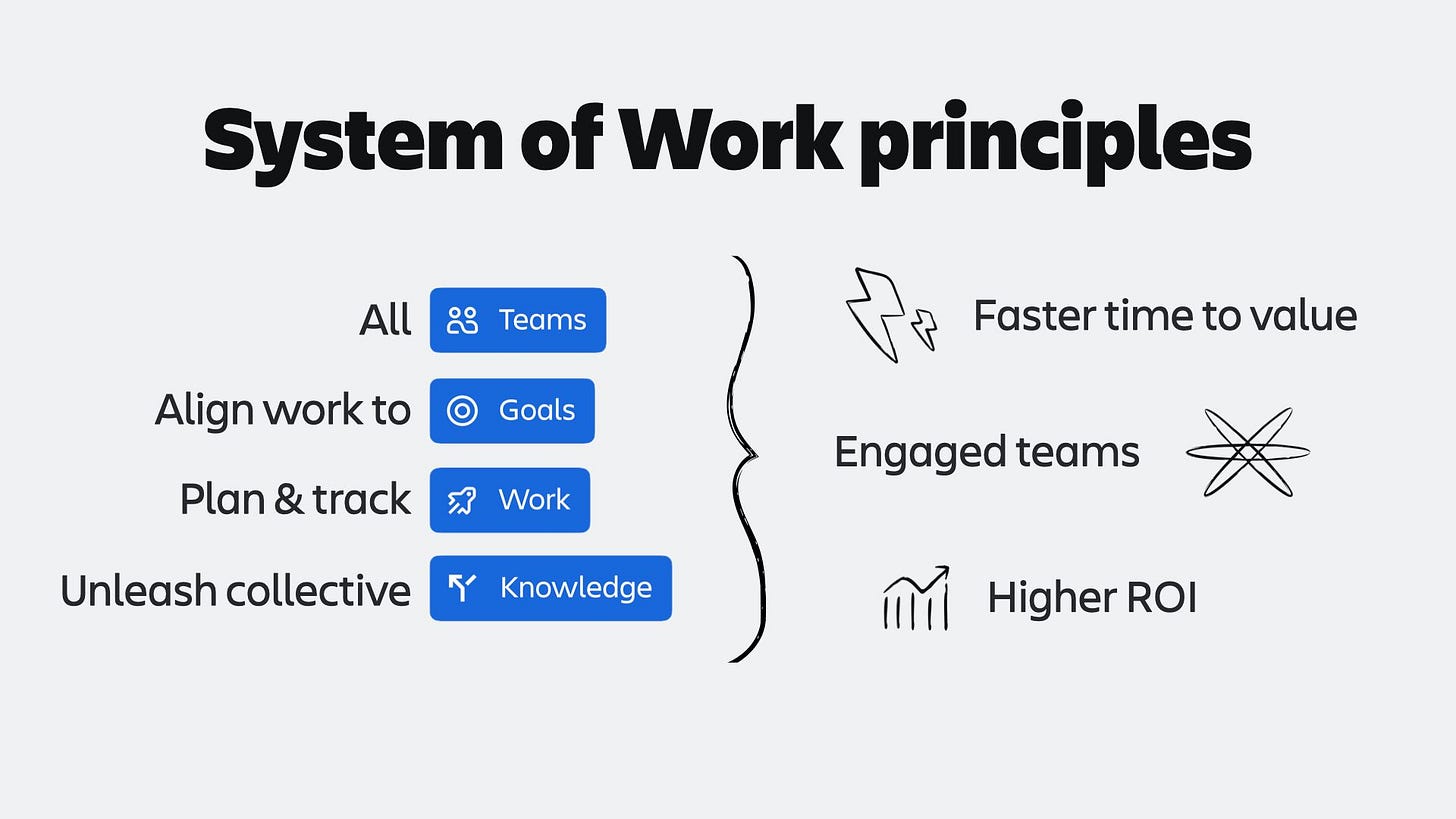Goals That Matter: The Atlassian Blueprint
How transparent tracking and ruthless focus created their culture of accountability
After 25 years of leading teams and building companies, if you forced me to pick one tool to make an organization successful, it's this: the ability to set clear goals, track progress honestly and transparently, and have clear accountability.
Unfortunately, most organizations stink at it: goals aren't clear or measurable, priorities are impossible to discern, and accountability evaporates as the organization grows.
But it's absolutely possible to do it well, and Atlassian is the proof. My recent conversation with Molly Sands, Head of Teamwork Lab at Atlassian, illuminated how leadership, culture, and systems all converge to make it work. Atlassian has built an impressive system for goal-setting and tracking that drives their success, creating transparency and focus across a complex global organization.
Molly Sands at Desana Forward, November 2024
"Most people think goal-setting is about setting the goal, but that's actually the easiest part," Molly told me. "The hard part is the muscle of tracking progress, making it visible, and creating a rhythm where discussions about goals happen naturally."
I've found goal-setting itself to be hard at numerous organizations—not the mechanics of defining SMART goals, but leadership discipline to prioritize ruthlessly. Too often, executives want more goals than they have employees to execute them.
The broader challenge resonates with what I've seen across countless organizations: the struggle to move beyond the activity trap—where busy work masquerades as progress—to a truly outcomes-driven culture.
The Atlassian Approach: Radical Transparency
What separates Atlassian from most organizations is their commitment to transparency. In most companies, goals cascade down, but visibility rarely extends beyond your immediate team.
"At Atlassian, anyone can see any team's goals across the entire company," Molly explained. "We have a tool where you can search and 'subscribe' to other teams' goals. This creates natural alignment because people can see connections between what they're doing and what others are working on."
This transparency extends to progress updates. Teams at Atlassian aren't just expected to report completion—they share real-time status, risks, and blockers.
"We've built a culture where honest assessment of progress isn't seen as failure," Molly emphasized. "Missing or being off-track isn't a problem if you're transparent about it. The problem comes when you hide challenges until it's too late to course-correct."
This echoes what I saw at Google, where we established clear standards for what "good" looked like: 80-90% attainment on key results each quarter. If everything was green, you weren't pushing far enough; if everything was red, people were burning out (or you were terrible at estimating). If you reported green until the end of quarter and missed, that was a bigger problem.
Focus: The Power of Less
Atlassian enforces remarkable discipline around focus, with every team limited to 3-5 goals per quarter. This constraint might seem restrictive, but it creates clarity about what truly matters.
"When everything is important, nothing is important," Molly noted. "We found that teams with more than five goals were actually achieving less than teams with fewer, more focused goals."
I’ve had mixed success helping leaders deal with loss aversion: a cognitive bias where leaders avoid making tough prioritization decisions because they perceive the potential losses from narrowing focus as more painful than the potential gains from concentrated effort.
I learned the importance of focus in my startup days, where we maintained a Top 10 list of key initiatives with specific deliverables and owners, updated monthly. Limited resources created clear scarcity, so limiting the number of “asks” drove productivity. The most valuable aspect wasn't the difference between positions 4 and 8 on the list — it was that an engineer asked to work on something not on the list could say "that's not on the list." That permission to say no is incredibly powerful.
"The hardest part of my job is helping leadership teams make those tough tradeoff decisions," Molly admitted. "Everyone wants to do everything, but forcing prioritization is how we ensure the most important work gets done."
Atlassian’s Principles for Effective Teamwork
The Operational Rhythm
What's particularly impressive about Atlassian's approach is how they've simplified the operational aspects of goal tracking.
"We've made it incredibly easy to update goals," Molly explained. "Teams spend just 15-20 minutes a month on updates. We're not asking for essays—just straightforward assessments of progress, risks, and what's changed."
This lightweight, “tweet-sized” update approach removes the administrative burden that often kills goal-tracking initiatives. It's not about elaborate documentation—it's about the conversation that follows.
"Updates happen monthly, with executive reviews built into this cadence," Molly told me. "But our process allows for quarterly adjustments. We expect about 20-30% of goals to shift each quarter as we learn and as the business environment changes."
At Slack, we built similar visibility tools that allowed everyone on the team to track progress against measurable goals. This transparency made it easier to get everyone aligned and allowed people to ask for help when something was off track.
Building the Muscle: Culture Over Tools
While Atlassian has invested in tools to support their process and has some great products that enable companies to do this work well at scale, Molly emphasized that culture is the real driver.
"The tools are just enablers—we could do this with spreadsheets if we had to," she said. "What matters is the expectation that everyone updates goals in a timely fashion, that leadership takes these updates seriously, and that we create psychological safety around honest assessments."
That psychological safety is crucial. Molly described how they've worked to eliminate the fear of "missing" targets:
"We've explicitly decoupled goal attainment from performance evaluation. Meeting 100% of a modest goal isn't as valuable as achieving 70% of an ambitious one that moves the business forward significantly."
This reflects what I saw at Google, where ambitious goals that stretched teams were valued over safe bets. The focus was on "landings not launches"—did you drive adoption and usage? It's harder to measure but far more meaningful than tracking activity.
Getting Started: First Steps
Not every organization needs a system as sophisticated as Atlassian's to start shifting to outcomes-based management. The key is to begin building the muscle.
"Start small," Molly advised. "Pick one team or department, set 3-5 meaningful goals, and commit to a monthly rhythm of updates and discussions. Then expand from there as you learn what works in your context."
I couldn't agree more. You won't get it perfect the first time—or ever. But continuous investment yields real results. And you don't need to wait for top-down implementation; your own team will appreciate the clarity you bring to their work lives.
The Payoff: Beyond Performance
What struck me most in my conversation with Molly was how their goal system ties in with their culture.
"This isn't just about hitting numbers," she said. "It's about creating shared understanding, fostering collaboration across teams, and helping people see how their work connects to the bigger picture."
In an age where engagement is plummeting and employees hunger for meaning, this connection to purpose is invaluable.
"When people subscribe to goals from other teams and reach out to offer help, that's when you know the system is working," Molly noted. "We're seeing cross-functional collaboration that never would have happened otherwise."
The Bottom Line
Moving from monitoring activities to measuring outcomes isn't easy. It requires hard cultural shifts around transparency, accountability, and trust. You must invest at all levels in systems, communications, and training. And perhaps hardest of all, leadership has to walk the talk—consistently and visibly.
But as Atlassian has shown, the rewards are well worth the effort: greater focus, improved collaboration, and ultimately, better business results.
The best time to start was yesterday. The second-best time is today. What are you waiting for?








One of the biggest struggles I see with goal setting is that people set broad, lofty goals without making them measurable and then forget to reassess. In some organizations, it feels more like a box-checking exercise than an ongoing, active process.